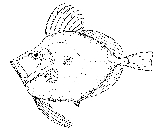
Mirror dory
Encyclopedia
The mirror dory, Zenopsis nebulosa, is a dory
of the family
Zeidae
, found in the southern Pacific Ocean
at depths of between 30 and 800 m. Its length is up to 70 cm.
The mirror dory has a high first dorsal fin
containing 9 spiny rays, and about 27 soft rays in the second. The forward set of pelvic fin rays are very elongated. There are large flat spines on each side of the body at the base of the dorsal
and anal fins.
The scale
less body is a uniform silver, so bright as to be almost mirror-like, with an indistinct dark patch in the middle of each flank.
In the month-long NORFANZ Expedition of 2003 which was examining the biodiversity
of the seamount
s and slopes of the Norfolk Ridge
, 117 specimens averaging 1kg (2.2lb), were collected from four locations.
Zeidae
The Zeidae are a family of large, showy, deep-bodied zeiform marine fish—the "true dories". Found in the Atlantic, Indian, and Pacific Ocean, the family contains just six species in two genera...
of the family
Family (biology)
In biological classification, family is* a taxonomic rank. Other well-known ranks are life, domain, kingdom, phylum, class, order, genus, and species, with family fitting between order and genus. As for the other well-known ranks, there is the option of an immediately lower rank, indicated by the...
Zeidae
Zeidae
The Zeidae are a family of large, showy, deep-bodied zeiform marine fish—the "true dories". Found in the Atlantic, Indian, and Pacific Ocean, the family contains just six species in two genera...
, found in the southern Pacific Ocean
Pacific Ocean
The Pacific Ocean is the largest of the Earth's oceanic divisions. It extends from the Arctic in the north to the Southern Ocean in the south, bounded by Asia and Australia in the west, and the Americas in the east.At 165.2 million square kilometres in area, this largest division of the World...
at depths of between 30 and 800 m. Its length is up to 70 cm.
The mirror dory has a high first dorsal fin
Dorsal fin
A dorsal fin is a fin located on the backs of various unrelated marine and freshwater vertebrates, including most fishes, marine mammals , and the ichthyosaurs...
containing 9 spiny rays, and about 27 soft rays in the second. The forward set of pelvic fin rays are very elongated. There are large flat spines on each side of the body at the base of the dorsal
Dorsal fin
A dorsal fin is a fin located on the backs of various unrelated marine and freshwater vertebrates, including most fishes, marine mammals , and the ichthyosaurs...
and anal fins.
The scale
Scale (zoology)
In most biological nomenclature, a scale is a small rigid plate that grows out of an animal's skin to provide protection. In lepidopteran species, scales are plates on the surface of the insect wing, and provide coloration...
less body is a uniform silver, so bright as to be almost mirror-like, with an indistinct dark patch in the middle of each flank.
In the month-long NORFANZ Expedition of 2003 which was examining the biodiversity
Biodiversity
Biodiversity is the degree of variation of life forms within a given ecosystem, biome, or an entire planet. Biodiversity is a measure of the health of ecosystems. Biodiversity is in part a function of climate. In terrestrial habitats, tropical regions are typically rich whereas polar regions...
of the seamount
Seamount
A seamount is a mountain rising from the ocean seafloor that does not reach to the water's surface , and thus is not an island. These are typically formed from extinct volcanoes, that rise abruptly and are usually found rising from a seafloor of depth. They are defined by oceanographers as...
s and slopes of the Norfolk Ridge
Norfolk Ridge
The Norfolk Ridge is a long submarine ridge running between New Caledonia and New Zealand, about 1300 km off the east-coast of Australia. Little is known about the Norfolk Ridge; however, it generally lies about 2000 m below sea level and consists of Late Cretaceous continental crust. It is...
, 117 specimens averaging 1kg (2.2lb), were collected from four locations.

